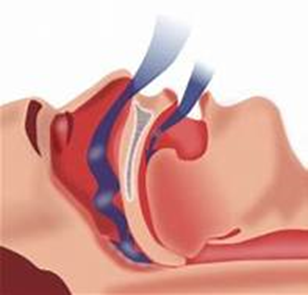A nurse is assessing a client who has obstructive sleep apnea (OSA). Which of the following findings should the nurse expect?
Hypotension.
Pneumonia.
Decreased energy.
Thyroid disease.
The Correct Answer is C
The correct answer is: C. Decreased energy.
Choice A reason: Hypotension is not typically associated with obstructive sleep apnea (OSA). OSA is more commonly linked with hypertension due to the frequent arousals during sleep that activate the sympathetic nervous system, leading to increased blood pressure.
Choice B reason: Pneumonia is an infection of the lungs and is not a direct consequence of OSA. While OSA can affect the respiratory system, it does not cause pneumonia. However, individuals with OSA may have a higher risk of respiratory infections due to compromised breathing during sleep.
Choice C reason: Decreased energy is a common symptom of OSA. People with OSA experience repeated episodes of partial or complete upper airway obstruction during sleep, leading to disrupted sleep patterns and insufficient rest. This results in daytime sleepiness and fatigue, which are hallmark signs of the condition.
Choice D reason: Thyroid disease, specifically hypothyroidism, can be associated with OSA, but it is not a direct finding of the condition. Hypothyroidism can lead to changes in the soft tissues of the upper airway and contribute to the development of OSA, but it is not a symptom used to diagnose OSA.

Nursing Test Bank
Naxlex Comprehensive Predictor Exams
Related Questions
Correct Answer is B
Explanation
The correct answer is choice B. "Why do you think your husband needs more medication when he is asleep?"
Choice A rationale:
"Your husband should decide when more medication is needed.” This response is incorrect because it implies that the partner has the authority to decide when the client needs pain medication, which violates the purpose of a PCA pump. A PCA pump is specifically designed for client-controlled pain management, ensuring that the patient, not anyone else, controls when they receive pain medication. Allowing someone else to press the button can lead to overmedication and safety risks.
Choice B rationale:
"Why do you think your husband needs more medication when he is asleep?" This response is correct because it prompts the partner to reflect on their actions and provides an opportunity for the nurse to educate about the proper use of PCA pumps. It addresses the immediate issue without being confrontational and opens the door for further discussion on the importance of client safety and correct PCA use.
Choice C rationale:
"It's a good idea to help make sure your husband can sleep comfortably.” This response is incorrect as it endorses inappropriate and unsafe behavior. It encourages the partner to continue pressing the PCA button, risking the client's safety due to potential overmedication, which can lead to severe complications, such as respiratory depression.
Choice D rationale:
"Next time you think he needs more medication, call me and I'll push the button.” This response is incorrect because it contradicts PCA protocols and removes the control from the client. The nurse is responsible for monitoring the client’s pain and safety, not administering medication upon another person’s request. This approach also increases the risk of dosing errors and undermines the purpose of patient-controlled analgesia.
Correct Answer is C
Explanation
Choice A rationale:
The primary care provider (PCP) is responsible for prescribing the PCA but does not typically program the PCA pump. The PCP may set the initial parameters for the PCA, such as the dose and lockout interval, but the actual programming and operation of the PCA pump is typically carried out by the nursing staff.
Choice B rationale:
Pharmaceutical companies manufacture and provide medications, including the medications used in PCA, but they do not program PCA pumps. Programming and administration of the PCA are nursing responsibilities.
Choice D rationale:
Licensed Practical Nurses (LPN) or Licensed Vocational Nurses (LVN) can assist in the administration and monitoring of PCA, but they do not typically program the PCA pump. Registered nurses are usually responsible for the programming and operation of PCA pumps.
Whether you are a student looking to ace your exams or a practicing nurse seeking to enhance your expertise , our nursing education contents will empower you with the confidence and competence to make a difference in the lives of patients and become a respected leader in the healthcare field.
Visit Naxlex, invest in your future and unlock endless possibilities with our unparalleled nursing education contents today
Report Wrong Answer on the Current Question
Do you disagree with the answer? If yes, what is your expected answer? Explain.
Kindly be descriptive with the issue you are facing.
